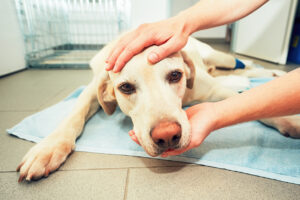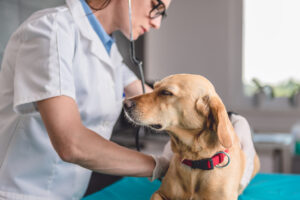What is Leptospirosis?
Leptospirosis is a disease caused by infection with Leptospira bacteria. These bacteria can be found world wide in soil and water. Leptospirosis is zoonotic. This means it can be transmitted from animals to people or, more specifically, a disease that normally exists in animals but that can infect humans. It is an infection of bacterial spirochetes. These are bacteria which burrow into a dog’s skin. Leptospires spread throughout the body reproducing in the liver, kidneys, central nervous system, eyes and reproductive system.
Risk factors
While it can occur anywhere, areas with warm climates and higher annual rainfalls are more susceptible. Dogs are more affected by this disease than cats. It is rare in cats. Exposure can occur from the following sources:
- Contaminated water sources including rivers, lakes, streams.
- Rural surroundings at risk of infection from affected wildlife, farm animals, contaminated water sources.
- Infected wildlife in the backyard.
- Contact with rodents or other infected dogs.
How does infection occur?
Infection can occur in the following ways: bacteria enters through your dog’s mucous membranes or an open wound; exposure occurs through infected urine or urine contaminated soil, water, food or bedding; a bite from an infected animal; eating infected tissues or carcasses; and in rare cases, the bacteria can pass from the placenta of a mother dog to her puppies through breeding.
What are the signs of leptospirosis?
Some infected dogs show no signs of illness. Some have mild illness and can recover spontaneously without treatment. Others can develop serious illness which can be deadly. While some dogs may not display any symptoms, they can still be carriers who put other dogs at risk.
Symtoms include: sudden fever, shivering, stiffness in muscles or legs, reluctance to move, increased thirst, changes in frequency or amount of urination, dehydration, vomiting, diarrhea, loss of appetite, lethargy, yellow skin and/or whites of eyes, painful eye inflammation, depression, spontaneous cough, swollen lymph nodes, kidney failure, liver failure, lung disease, or difficulty breathing. Bleeding disorders can occur causing blood-tinged vomit, urine, stool, or saliva. Nose bleeds can occur. Your dog may have swollen legs or excess fluid in their chest or abdomen.
Whether your dog’s internal organs are affected, depend on their immune system. Even if their immune system fully eradicates the infection, bacteria can remain in their kidneys. Here it can reproduce and infect their urine. If allowed to progress, infection of the kidneys or liver can be fatal. Younger dogs with weaker immune systems are at highest risk for serious complications.
How is leptospirosis diagnosed?
 Many of the signs of leptospirosis can be associated with other diseases. Therefore, providing your veterinarian with a thorough history of your dog’s health, including any possible exposure to this bacteria, is important. Your veterinarian may recommend a number of tests to confirm a diagnosis. These tests include various blood and urine tests. If routine testing indicates leptospirosis may be a possibility, then more definitive testing may be necessary to confirm a diagnosis.
Many of the signs of leptospirosis can be associated with other diseases. Therefore, providing your veterinarian with a thorough history of your dog’s health, including any possible exposure to this bacteria, is important. Your veterinarian may recommend a number of tests to confirm a diagnosis. These tests include various blood and urine tests. If routine testing indicates leptospirosis may be a possibility, then more definitive testing may be necessary to confirm a diagnosis.
What is the treatment for leptospirosis?
Treatment with antibiotics is highly effective in most cases. Antibiotics are administered in two phases. The first phase will treat the acute infection. The second phase will treat the low grade infection which lingers in “carrier” dogs. If treated early and aggressively, chance of recovery is good although kidney or liver damage remains a risk.
In cases that are more severe, hospitalization may be necessary including treatment with intravenous fluid therapy. For severe cases involving kidney or liver damage, the prognosis is more guarded.
Are precautions necessary when treating leptospirosis?
If your dog is diagnosed with leptospirosis, several precautions to protect yourself and your family are recommended. These include:
- Administer antibiotics as prescribed by your veterinarian.
- Avoid contact with your dog’s urine.
- Clean any areas in your home where your dog has urinated using a disinfectant. Wear gloves to avoid contact.
- Don’t let your dog urinate near standing water or where people or other animals risk exposure.
- Wash your hands thoroughly after contact with your pet.
Though it is unpleasant, most cases of leptospirosis in humans are not life threatening. Symptoms are similar to those of the flu. Weil’s disease is a severe form of leptospirosis which can cause serious health issues and result in hospitalization. Children are most at risk of acquiring the illness from an infected pet due to their weaker immune systems. Treatment is with antibiotics. More serious cases may require intravenous antibiotics.

Can I vaccinate my dog against leptospirosis?
Vaccines that effectively prevent and protect dogs for at least one year are available. These vaccines are recommended for any dog at risk of exposure to this serious disease. Reducing your dog’s exposure to potential sources of leptospirosis is important. This will lessen their chances of infection. If you have any questions about leptospirosis or its vaccine, talk to your veterinarian to learn more about this disease.

